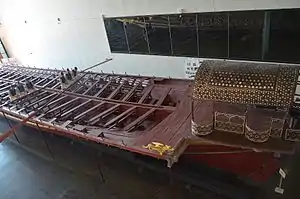Tarihi Kadırga
Tarihi Kadırga (Turkish for "historical galley") is an Ottoman galley constructed in the late 16th or early 17th century for the use of Ottoman sultans on inshore waters.[1][2] She is the only surviving original galley in the world,[1][3] and has the world's oldest continuously maintained wooden hull.[2]
 Tarihi Kadırga at the Istanbul Naval Museum | |
| History | |
|---|---|
| Name | Tarihi Kadırga |
| Builder | Imperial shipyard |
| Decommissioned | c. 1839 |
| Status | Museum ship |
| General characteristics | |
| Class and type | Galley |
| Length | 39.64 m (130.1 ft) |
| Beam | 5.72 m (18.8 ft) |
| Complement | 144 oarsmen |
Design
Tarihi Kadırga has a length of 39.64 metres (130.1 ft) and has a beam of 5.72 metres (18.8 ft), she was equipped with 24 oars, and crewed by 144 oarsmen.[1] She had two masts,[lower-alpha 1] but these are now removed.[1]
History
Tarihi Kadırga's date of construction is unknown, however it is presumed that she was built in Istanbul during the reigns of either sultan Murat III (1574 – 1595) or sultan Mehmet IV (1648 – 1687),[1][4] evidenced by AMS radiocabon dating and dendrochronological research.[4] The ship had a long service life, remaining in use until the reign of Sultan Mahmut II (1808 – 1839).[1][4][5] The first recorded mention of her dates from 1861, when the Istanbul newspaper Şehbal stated she was recorded by a French naval architect.[4][5] In 1885, the ship underwent major repairs ordered by Sultan Abdulhamid II,[4] in which decayed planks below the waterline were replaced, and the ship was refurbished.[4][5] The galley was kept in the Topkapi Palace until 1913, when she was moved to the Naval Arsenal at Kasimpasha.[5][6] By 1923, she was in a state of disrepair, with photographs published in The Mariner's Mirror showing damage to her lower strakes.[5] However, by 1939, another photograph published in National Geographic Magazine showed her condition to have improved.[5] The kiosk was restored in 1944, and the hull in 1950. During this restoration, some of the decoration on her hull was repainted by members of Istanbul University's Art Faculty.[5] She remained at Kasimpasha until 1956, when she was moved again, now to Beshiktash, where she stayed until her final move in 1970. This time she was moved by barge to the Istanbul Naval Museum.[5][6] She was given another restoration in 1982 and 1983, which included replacement of decorative elements and repainting of the entire ship.[5]
Gallery
Notes
- Other sources state she had only one mast[4]
References
- "The Historical Galley". denizmuzesi.dzkk.tsk.tr. 2021-11-24. Archived from the original on 8 October 2021.
- "Center for Maritime Archaeology and Conservation - Texas A&M University". nautarch.tamu.edu. Retrieved 2021-11-24.
- "Cornucopia Magazine". www.cornucopia.net. Retrieved 2022-03-16.
- "Liphschitz, N., 2014. The Kadirga galley in Istanbul – The Turkish Sultan's Caique: A dendrohistorical research. In: Environment and Ecology in the Mediterranean Rgion II (eds. R. Efe and M. Ozturk). Cambridge Scholars Pub. Pp.39-48. Cambridge".
{{cite web}}: CS1 maint: url-status (link) - "The INA Quarterly" (PDF).
- "KADIRGA galley - shipstamps.co.uk". shipstamps.co.uk. Retrieved 2021-11-24.




